How To Change Brush Size In Photoshop With Scroll Wheel
Here are twenty of my favorite shortcuts for the Brush and painting tools in Photoshop. Although I ofttimes use the Brush tool every bit the example, many of these shortcuts also work for other painting tools such equally the Pencil, Mixer Brush, Clone/Pattern Postage, Eraser, Slope, Paint Saucepan and more.
Resizing using the Subclass Keys
• Tap the left/right bracket decrease/increase brush size.
• Hold the left/right bracket to continuously decrease/increase castor size.
• To customize the keys used to increase/subtract brush size and hardness (as many international keyboards do not take brackets), under Edit > Keyboard Shortcuts – cull "Shortcuts For: Tools". Curl down (almost the lesser of the listing) and enter any single character to set a new shortcut for Decreasing/Increasing Castor Size.
Resizing Using the HUD (Heads-Up Display)
• On Mac: Command + Option (Mac) –elevate left/correct in order to decrease/increase brush size and upward/down to decrease/ increment brush hardness.
• On Windows: Command + Alt + Correct click -drag left/right to subtract/ increment brush size and up/down decrease/ increase brush hardness.
• To apply the change Brush Opacity (instead of the Brush Hardness), based on the vertical drag motion, select Preferences > Tools and uncheck "Vary Round Castor Hardness based on HUD vertical motility".
Custom Cursors
• To customize the display of the painting cursors, select Preferences > Cursors and select from the post-obit:
– Standard – to display the small iconic cursors
– Precise – to brandish cross hairs
– Normal Castor Tip – the circumvolve icon size represents pixels to be painted with greater than fifty% effect
– Full Size Brush Tip – the circumvolve icon size represents all pixels to be painted
– Bank check "Bear witness Cantankerous hairs in Brush Tip" – to easily see the heart of the brush
– Check Testify Only Crosshair While Painting – to display the cross hairs merely while painting
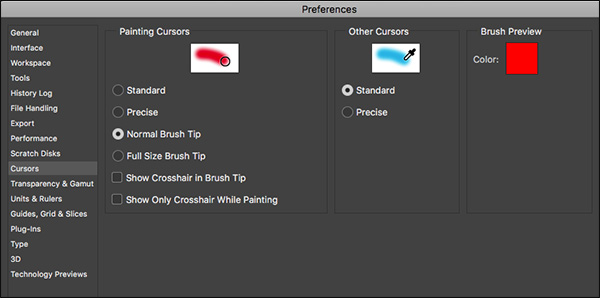
• To temporarily access Precise Cursors, enable the "caps lock" key.
• Choose to fix additional tools icons (such as the Eyedropper tool) to Standard or Precise.
• To change the Brush cursor preview color, click in the red swatch under Brush Preview and choose a new color.
Opacity and Flow
• Opacity controls the opaque/transparent quality of the paint (are you using an opaque metallic paint or a transparent varnish?). Menses controls the speed at which paint is laid downward (are y'all pressing the nozzle of the can of spray paint just a little, or all the way down?).
![]()
• To alter the Opacity, tap a numeric key to add together the percentage of the tapped number. (1 = 10%, 2= 20% etc. and 0 = 100%). Tapping two numbers chop-chop will requite you that exact amount (5 + 4 = 54%).Annotation: If yous have a tool selected that doesn't have an opacity setting in the Selection bar, these shortcuts will bear on the Opacity option on the Layers panel.
• Shift + borer a numeric cardinal changes the Catamenia value.
• If the selected brush has the Airbrush attribute enabled, tapping the numeric keys will change the Flow by default and calculation the Shift key will modify Opacity.
Toggle between Painting and Erasing
• Concur the Tilda key to toggle between painting and erasing with the electric current brush.Note: with the Tilda cardinal held downwardly, the paint brush is really painting using the Articulate blend way.
The Airbrush Attribute
• Pick + Shift + P (Mac) | Alt + Shift + P (Win) toggles the Airbrush attribute on/off.
![]()
• To customize this shortcut, select Edit > Keyboard Shortcuts and choose "Shortcuts For: Tools". Scroll down (nigh the bottom of the listing) and enter a unmarried letter to set a new shortcut to Toggle Castor Airbrush Mode.
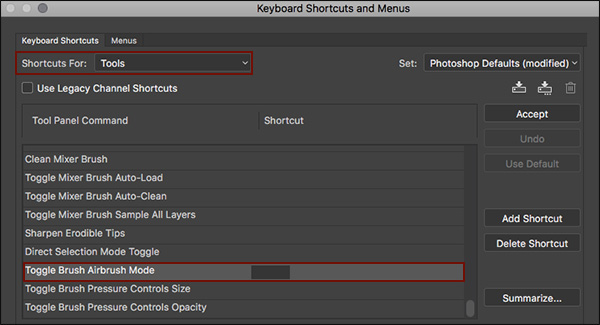
Irresolute the Blend Mode
• To quickly cycle through a painting tool's blend modes, hold the Shift key and tap the "+" (plus) or "-" (minus) to move forward or backwards through the list. Note: If you have a tool selected that does non have Blend Manner options in the Options bar, these shortcuts will affect the blend mode options on the Layers panel.
In addition, each blend style has a unique keyboard shortcut. They all begin with Option + Shift (Mac) | Alt + Shift (Win) and then a single letter of the alphabet.
Normal + N, Deliquesce + I, Backside + Q, Clear + R
Darken + K, Multiply + 1000, Color Burn + B, Linear Burn + A,
Lighten + G, Screen + S, Colour Contrivance + D, Linear Contrivance + West,
Overlay + O, Soft Light + F, Hard Light + H, Vivid Low-cal + V, Linear Lite + J, Pin Light + Z, Hard Mix + L
Deviation + E, Exclusion + X
Hue+ U, Saturation+ T, Colour + C, Luminosity + Y
Note: I don't know of shortcuts for Darker Color, Lighter Color, Subtract, or Divide.
The Brush Preset Picker
• With a painting tool selected, Control -click (Mac) | Correct -click (Win) anywhere in the image area to admission the Brushes Preset Picker.
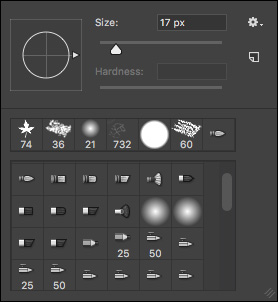
• Tap ',' or '.' to move to the "previous" or "adjacent" brush in the listing in the Brush Presets Panel. (Shift + ',' or '.' moves to the first/concluding brush in the list. To customize this shortcut, select Edit > Keyboard Shortcuts and cull "Shortcuts For: Tools". Roll down (almost the lesser of the list) and enter any unmarried character to gear up a new shortcut to move through the castor presets.
Locking Brush Attributes
• The 2 most common pressure sensitive brush attributes (Opacity and Size) can be locked on/off using the icons in the Options Bar. When enabled, the force per unit area sensitive pen/tablet control the opacity/size. When off, the opacity/size is controlled past the brush preset. To assign a custom keyboard shortcut to turn these options on/off, select Edit > Keyboard Shortcuts and cull "Shortcuts For: Tools". Scroll down (nigh the bottom of the list) and enter any single grapheme to set a new shortcut for either Toggle Brush Pressure Controls Size or Toggle Brush Pressure Controls Opacity.
![]()
• To lock additional brush attributes (allowing y'all to move freely between brush presets while retaining specific attributes), click to the right of the attribute grouping (Shape Dynamics, Scattering etc.), on the Castor panel.

• If yous have a castor configured, and simply want to change the tip of the brush (while leaving all of the other brush attributes as they are), on the Castor console, click Brush Tip Shape and select another shape.
Color Dynamics
• When using Brushes, colour tin be applied on a per stroke or a per tip basis. In the example beneath the first three strokes take the Utilise Per Tip checked. Because the Hue, Saturation and Brightness settings all accept xx% Jitter values, each stoke varies in color. The second three strokes accept the Utilise Per Tip unchecked resulting in each pigment stoke having a solid stroke, the color but changing as each new stroke is painted (not within a single stroke).
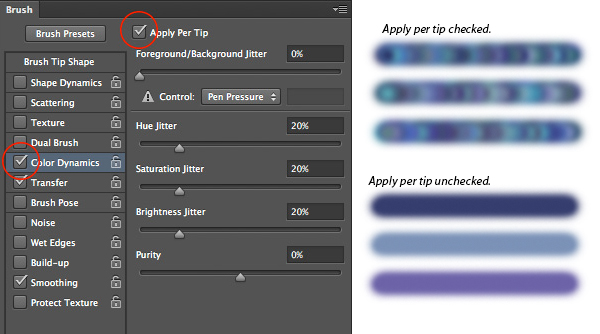
Painting Dotted Lines
• In order to create a "dotted" line instead of a solid paint stroke, display the brushes panel and click on Castor Tip Shape. Elevate the Spacing slider to the right until the desired amount of space falls betwixt each mark. Try changing the roundness and bending for variation. Note: for more structured dotted and dashed lines, endeavour using the Shape or Pen tools with a stroke applied.
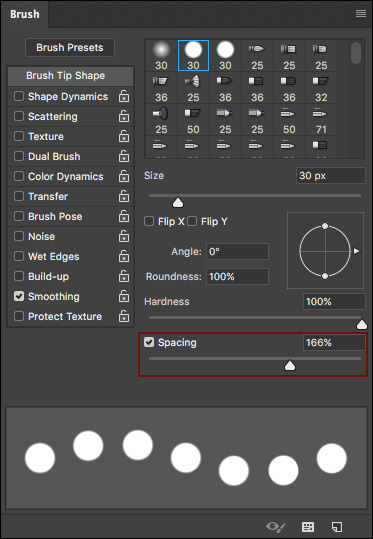
Painting Straight Lines
• To paint a straight line, agree the Shift key while dragging a stroke. Or, click once with a painting tool, so release the mouse, agree the Shift key and click again to draw a direct line between the ii points.
Sampling Color While Painting
• Holding the Option (Mac) | Alt (Win) samples a colour with the eyedropper while using the painting tools.
Creating Fluid, Precise Paint Strokes that Simulate Pressure level Sensitivity
• To create fluid, precise stroke of pigment, showtime create a path using the pen tool. Then, make sure that the painting tool that y'all desire to utilise is prepare up with the correct options (such equally brush size and opacity etc.). Finally, from the Paths panel wing-out, menu, select Stroke path and select the desired tool. This technique works with several painting tools and can be extremely helpful for example, when using the Contrivance tool to add together a highlight along the edge of an object.
• To simulate pressure sensitivity when stroking a path, select the path in the paths panel, choose Stroke Path from the fly-out bill of fare, and bank check Simulate Pressure. Note, it is important to set upwardly your castor (or whatever tool you lot desire to use), too as information technology's attributes BEFORE you stroke the path.

In this illustration, the first path was stroked with a brush with the Simulate Force per unit area selection unchecked. The second and third paths both had the Simulate Pressure selection checked; the middle analogy demonstrating the brushes Opacity (under Transfer on the Castor Panel) set to Pen Pressure level, the right illustration demonstrating Opacity and Size (nether Shape Dynamics on the Castor Console) set to Pen Pressure.
Creating and Saving a Custom Brush
• To define a Custom brush, employ 1 of Photoshop's selection tools to select the desired area. Then, choose Edit > Define Brush Preset and give it a name. Notation: castor presets are gray-scale and use the selected foreground color to paint.
• The custom brush appears in the Brush Presets panel and can be hands modified (if desired) using the Brush panel (select the brush tip and and so modifying any additional attributes).
• Click the New Castor Preset icon on the Preset panel to save the custom brush with its attributes. To save the Brush preset and options set in the Options bar (blend manner, opacity etc.), equally well as the foreground color, click the New Tool Preset icon on the Tool Preset panel.
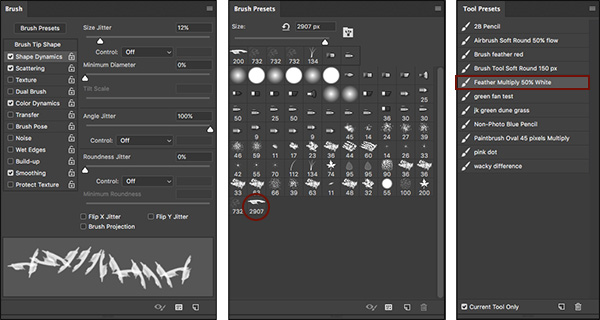
Afterwards defining a custom brush, I changed the Shape Dynamics and Scattering options in the Brush console and saved the (now modified) brush using the Brush Preset panel. So, to save the Brush and include it'southward custom options (the blend mode set to Multiply, the Opacity 50%, and white as the foreground color), I saved information technology every bit a Tool Preset.
Viewing the Active Brush
• Photoshop CC'due south has the ability to brandish the seven most recently used Brushes as well equally bespeak if the currently used preset has been modified. This video (Hidden Gems in Photoshop CC) shows you how. https://youtu.be/HJybNsKr37M?t=69
The Mixer Brush
• In that location are five actually useful customizable keyboard shortcuts specifically designed for the Mixer Brush. Choose Edit > Keyboard Shortcuts, and using the Shortcuts for "Tools" curl the to the bottom and enter custom keyboard shortcut to enable the pick(s):
Load Mixer Brush
Make clean Mixer Castor
Toggle Mixer Brush Motorcar-Load
Toggle Mixer Castor Car-Clean
Toggle Mixer Castor Sample All Layers
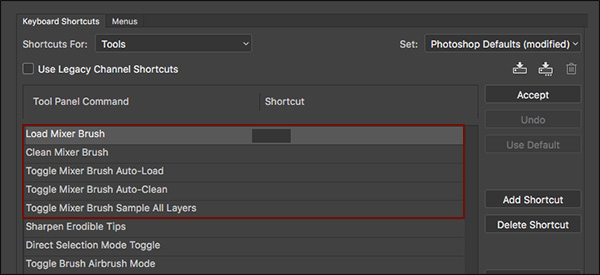
Notation: there is besides an option to assign a keyboard shortcut to Sharpen Erodible tips.
Changing Mixer Brush Options using the Keyboard
• When using the Mixer Castor tapping a numeric keys modify the "Wet" value.
• Shift + tapping a numeric primal changes the "Period" value.
• Choice + Shift (Mac) | Alt + Shift (Win) + number changes the "Mix" values.
• Typing 00 (zero, nix) in quick succession speedily sets the "Wet" and "Mix" values for the Mixer Brush to zero – resulting in a dry castor.
Fading Paint Strokes
• Immediately after painting a stroke, select Edit > Fade Brush Tool to change the opacity and/or modify the blend mode of the paint stroke. Note: This shortcut also works for a diversity of boosted commands including prototype adjustments, strokes, fills and filters.
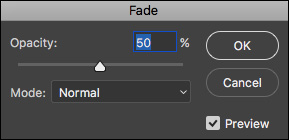
The Eraser Tool
• The Eraser tool has a special "Block" mode which gives you a eraser in the shape of a square. What'south unique is that when y'all zoom in and out on the image and apply the tool, it erases a certain portion of the screen – regardless of the zoom level.
![]()
• Holding the Choice (Mac) | Alt (Win) with the Eraser tool will erase with history. Annotation: when Photoshop opens a document, it takes (by default) a snapshot of the document that appears at the acme of the History panel – this is the "history" that the Eraser paints with. To change the "History" state (that the Eraser uses to paint from), click in any empty well to the left of the desired country in the History panel. Both states (the one chosen to "erase" with and the one that's being "erased" upon) must take respective layers and be in the same color mode.
The Paint Saucepan Tool
• The Paint Saucepan tin can make full with the Foreground color or a Design. With the Paint Bucket selected, cull which fill content option you adopt in the Options bar. Note: the Make full command (Edit > Make full) likewise has the pattern choice, but the Paint Bucket may exist faster than using a dialog box.
• To fill a transparent area of an image with the foreground color, set the Paint Saucepan's blend mode to Behind and click on the transparent area. To erase areas of an paradigm (based on the color clicked upon), set up the Paint Bucket'south blend manner to Articulate and click in the desired colour.
The Slope Tool
• When using the Gradient tool, check "Dither" on in the Options bar to minimize banding over long gradients.
![]()
• The Gradient tool has multiple styles to choose from (Linear, Radial, Angle, Reflected, and Diamond). '[' or ']' will move you lot quickly from ane to the next gradient style.
• ',' (comma) or '.' (flow) goes to previous or next gradient swatch in the Gradient Preset Picker. Shift + ',' (comma) or '.' (period) goes to starting time or concluding gradient swatch in the Gradient Preset Picker.
• Double clicking on a gradient stop in the Gradient Editor will bring up the color picker. Pick -drag (Mac) | Alt -elevate (Win) on a gradient stop to duplicate it.
Paint Symmetry in Photoshop
• In this episode of three, two, 1, Photoshop! Paint Symmetry, Julieanne demonstrates how to unlock the Radial Pigment Symmetry's hidden features in Photoshop. https://youtu.be/IP2LIPZVc94
And some boosted videos:
The Oil Paint Filter in Photoshop CC – In this video, Julieanne demonstrates how to utilise a painterly expect to an prototype using the completely re-coded Oil Paint filter.
The Secret to Photoshop's Art History Brush – In this video, Julieanne demonstrates the power of the Art History castor and its ability to continuously sample from whatsoever history state or snapshot.
Copyright © 2022 Julieanne Kost.
All rights reserved.
How To Change Brush Size In Photoshop With Scroll Wheel,
Source: https://jkost.com/blog/2017/05/brushes-and-painting-tool-shortcuts-in-photoshop-cc.html
Posted by: devaughngeoppince1952.blogspot.com


0 Response to "How To Change Brush Size In Photoshop With Scroll Wheel"
Post a Comment